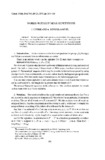| dc.contributor.author | Currie, J. | |
| dc.contributor.author | Bendor-Samuel, A. | |
| dc.date.accessioned | 2019-06-19T14:00:49Z | |
| dc.date.available | 2019-06-19T14:00:49Z | |
| dc.date.issued | 1992-06-01 | |
| dc.identifier.citation | Currie, J., and A. Bendor-Samuel. "Words without Near-Repetitions." Canadian Mathematical Bulletin 35(2) (1 June 1992): 161-166. DOI: 10.4153/CMB-1992-023-6. | en_US |
| dc.identifier.issn | 0008-4395 | |
| dc.identifier.uri | http://hdl.handle.net/10680/1697 | |
| dc.description.abstract | We find an infinite word w on four symbols with the following property: Two occurrences of any block in w must be separated by more than the length of the block. That is, in any subword of w of the form xyx, the length of y is greater than the length of x. This answers a question of C. Edmunds connected to the Burnside problem for groups. | en_US |
| dc.description.sponsorship | The research of the first author was supported by an NSERC Operating Grant. The second author was supported by an NSERC Undergraduate Summer Research Award. | en_US |
| dc.description.uri | https://www.cambridge.org/core/journals/canadian-mathematical-bulletin/article/words-without-nearrepetitions/F86509D865F222F1FC63ACA8545C069E | en_US |
| dc.language.iso | en | en_US |
| dc.publisher | Canadian Mathematical Society | en_US |
| dc.rights | info:eu-repo/semantics/openAccess | en_US |
| dc.subject | Infinite words | en_US |
| dc.subject | Pattern avoidance | |
| dc.title | Words without Near-Repetitions | en_US |
| dc.type | Article | en_US |
| dc.identifier.doi | 10.4153/CMB-1992-023-6 | en_US |

